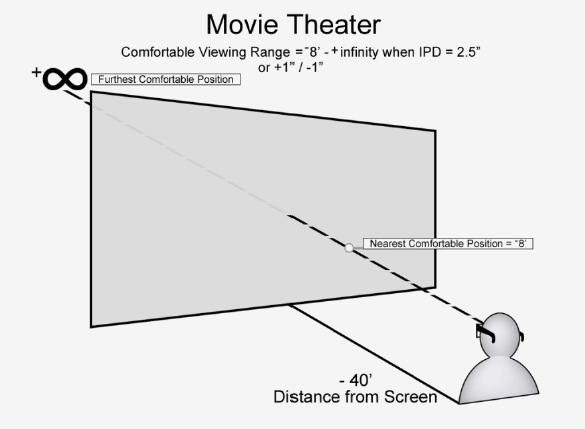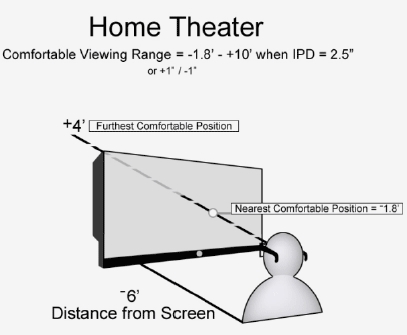3DTV: Home and the Range
Most people don’t live in movie theaters. That could be a problem for 3-D TV.
It wouldn’t be the first time that TV offered an experience different from that of a cinema auditorium. In 1961, NBC Saturday Night at the Movies began with the 1953 movie How to Marry a Millionaire, shot in an aspect ratio roughly twice as wide as television’s and framed to emphasize the wider shape. Body parts were truncated, TV sets couldn’t deliver the movie’s resolution, lit living rooms offered much less contrast ratio than dark theaters, and viewing on one’s own wasn’t psychologically the same as being in a crowd of moviegoers (thus the invention of the laugh track). 3-D simply adds to the challenges.
Good 3-D is not trivial, regardless of where it’s being viewed. Consider just camera lenses. They have been specified by widest and tightest shot angles, light-gathering capability, optical aberrations, linear resolution, and the like, but manufacturers have never specified how pairs of their lenses match up in, say, vertical shift through the zoom range. A slight mismatch between the two eye views of stereoscopic 3-D can make audiences queasy, even if everything else is perfect. Unfortunately, eliminating vertical displacement might not be enough.
Here’s a link to an essay on “3-D in the Home” in the Technical Documentation section of the web site of In-Three, a company that developed a process called “Dimensionalization” to convert “flat” material to stereoscopic 3-D: http://www.in-three.com/3DintheHomev2.html And here is a diagram taken from that essay and used here with permission. It depicts comfortable 3-D viewing conditions in a movie theater.

It shows a viewer at a nominal 40-foot viewing distance from the screen and indicates that such a viewer would be comfortable watching scenic elements as far behind the screen as an infinite distance and as close as eight feet in front of the screen. And here’s another diagram from the essay, this time showing home-theater conditions:

Here the viewer is shown at a distance of just six feet from the screen. The maximum stereoscopic depth is shown to be just four feet behind the screen. The closest comfortable viewing point is put at less than two feet in front of the screen.
Why the big difference? The essay offers an explanation and a discussion of what it refers to as a “comfort zone.” Something similar was discussed by Professor Martin Banks of the University of California at Berkeley at the SMPTE Digital Cinema Summit in April. He talked about evidence that “a vergence-accommodation conflict can cause fatigue and discomfort.”
Vergence, more commonly called convergence (though that term also refers to such things as the intersection of television and computer technologies), is the angular aiming of our eyes at objects at different distances. Looking at an infinite distance, eyes point straight ahead; looking at the nose between them, they aim inward at a sharp angle.
Accommodation is the focusing of an eye’s lens based on viewing distance. Again, the closer the object, the more the accommodation that takes place (squeezing the lens from its edges to make it thicker). At infinite distance, the lens muscles relax completely.
Both vergence and accommodation muscles send distance feedback to the brain. Put red text over a blue background, and it might seem to float off the screen or page because the simple lenses in our eyes need to focus closer for red than for blue. With that exception, however, real-world vision normally involves the same distance feedback from both sets of muscles.
Stereoscopic 3-D, however, involves accommodation at a fixed distance (the screen) with vergence at different distances, depending on the desired depth effect. The idea that the difference can be a viewing problem is not exactly new. The American Journal of Physiological Optics reported that “one of the most common causes of eye-strain consists in an unconscious attempt on the part of the observer to modify the normal coördination of the ocular reflexes of accommodation and convergence.” That was in 1926.
In a movie theater, viewers are sufficiently far from the screen that accommodation-vergence differences aren’t really an issue. For home TV they seem to be much more significant and for hand-held devices even more so.
So, what are the options? One is to ignore the issue. It might cause discomfort for viewers, but that discomfort might eventually go away as they learn to deal with 3-D TV, in the same way that sore muscles after hiking or skiing go away with regular practice.
At the other extreme, we might simply wait for full-motion, full-color holography. There have been demonstrations of it at MIT and at Japan’s National Institute of Information and Communications Technology, the latter showing a system at the 2009 NAB convention in Las Vegas.
It’s also possible simply to restrict the home-TV stereoscopic range, as shown in In-Three’s essay. For news, talk, game, and children’s shows and perhaps even sitcoms, the range could be sufficient to capture the depth of what’s being shot in a studio. For out-of-studio events, however, the result can be a sensation of looking through the eyes of a giant and seeing unnaturally shortened distances. Here, too, it’s possible that viewer training will eventually reduce the giant’s-eyes sensation.
Perhaps it’s worth noting that concerns about physiological effects of TV viewing predate today’s 3-D TV (though the first 3-D TV broadcast was in 1928). Due to the simple-lens color-focus problem, might color TV make viewers sick? That’s an issue investigated by the National Television System Committee, the first NTSC, in 1941.
Tags: 3-D, 3D, 3DTV, holographic, In-three, stereoscopic, vergence-accommodation,

No comments yet. You should be kind and add one!
The comments are closed.